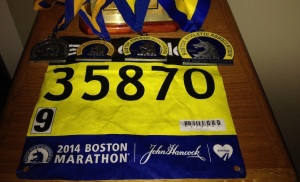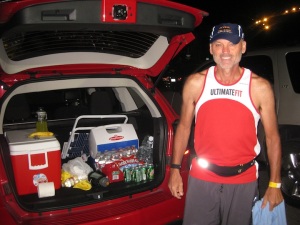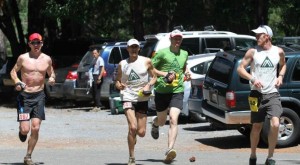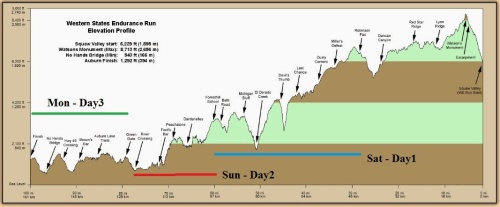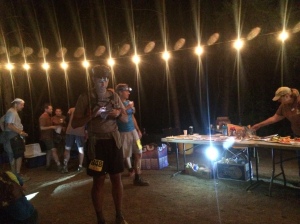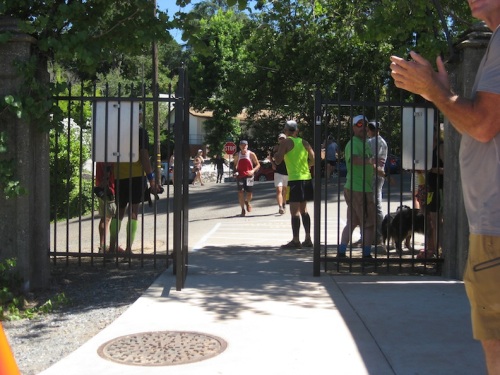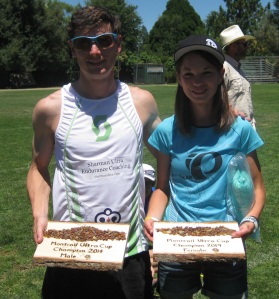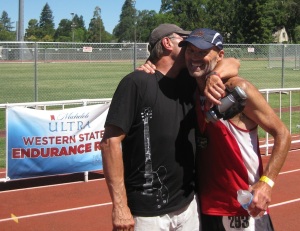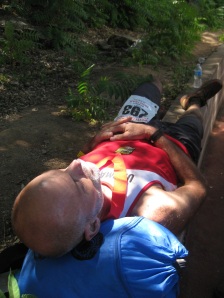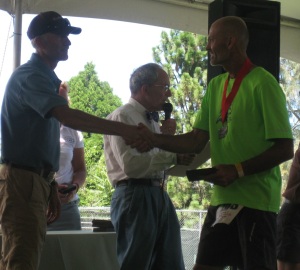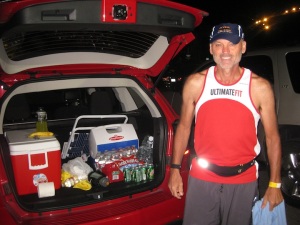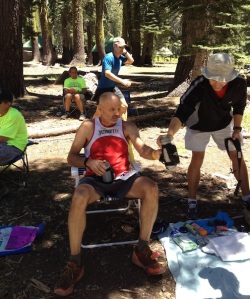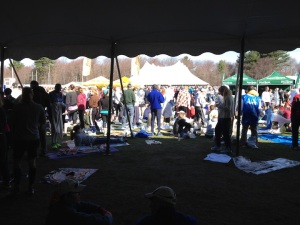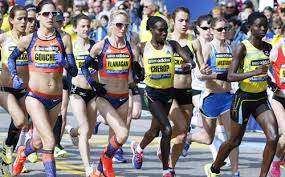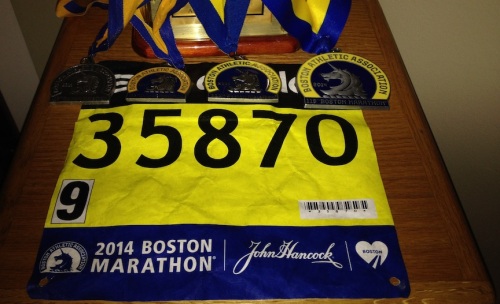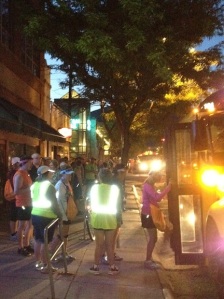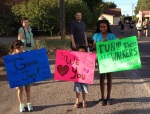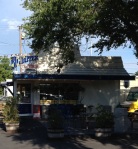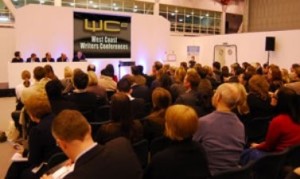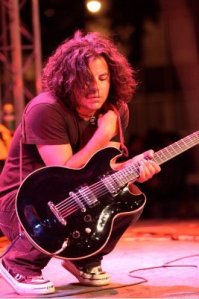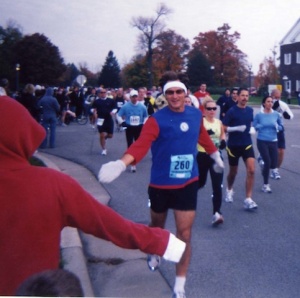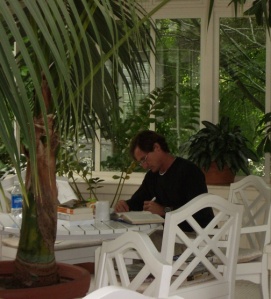(This is part 2 of my story about the 2014 Boston Marathon. The 2015 race is Monday, April 20.)
It began with the invitational entry four-time Boston Marathon champion Bill Rodgers transferred to me. It ended with a scrumptious lobster pie dinner hosted by my family.
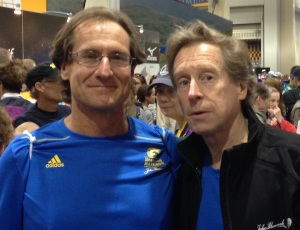
The King and I: With Bill Rodgers at 2014 Boston Marathon, after he gave me his invitational entry so I could run the most important Boston ever.
In between was the most meaningful race of my life, and the lives of most others in the field: the 2014 Boston Marathon. As we all know, the 2013 Boston Marathon ended in the horrible bombing tragedy. For months, the status of the 2014 race was in doubt, though my status was certain: I wouldn’t be going. A nagging ankle injury, sustained during qualifying season in 2013, sealed my fate.
Two things happened to change all that. BOSTON STRONG came alive and, to speak bluntly, shoved it right up the you-know-what of all would-be terrorists; and Boston Billy gave me the gift of a lifetime.
I showed up in Boston in shellshock after Bill arranged for his race slot to end up on my lap. Immediately, I felt a different vibe than the other three times I’d raced. Everywhere, people talked about it. The media devoted most of their news coverage to it. My relatives, who had seen my previous races, were beside themselves that this family member was running (as well as my cousin, Bryan Widmann).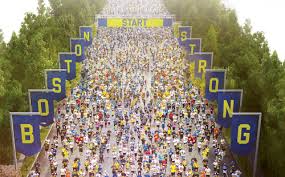 While I wasn’t yet in full marathon form (that would come six weeks later, in San Diego’s Rock & Roll Marathon), it didn’t matter. When you get an invite from a Boston legend, you go.
While I wasn’t yet in full marathon form (that would come six weeks later, in San Diego’s Rock & Roll Marathon), it didn’t matter. When you get an invite from a Boston legend, you go.
It’s safe to say several million runners worldwide wanted to toe the starting line at the 2014 Boston, to be a part of history, something beyond ourselves. To be among the 35,000 who got in?
As I write this, nearly a year later, I’m getting tears and goose bumps. That’s how much it meant.
I first understood the scope two days prior to the race, when I drove downtown and picked up my number and swag bag. The race expo was packed, beyond anything I’d ever seen. So was the entire Boston Back Bay area, especially Boylston Street, the site of so much carnage just a year before. My friend, Kathryn Van Artsdall, was also racing for the fourth time. Her husband, my longtime buddy Mitch Varnes, and I were trying to meet up. Good luck with that: too many people.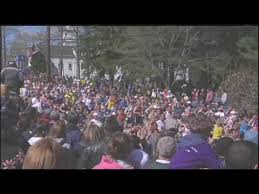
I then sought out Bill Rodgers, my hero when I was in high school and he was the world’s greatest marathoner. We’ve had a number of runs, get-togethers and good times during our friendship that began in 2008 (including a fabulous run at Walden Woods and Walden Pond, 25 miles to the west), but this was different. “Just run the best you can,” he whispered in my ear. “You’re starting in back since you’re a last-minute entry, so you won’t run your normal time. Forget about it. Soak up what goes on out there. You will never have an experience like this.”
How right he was. Here are a few of those experiences:
Starting line, Hopkinton: While standing in my corral, a drone flew overhead, huge snowplows blocking side streets, and law enforcement stood everywhere. They were scanning the throng like Secret Service agents while openly thanking we, the runners, for having the courage to return. I had never thought of us being courageous; it was more like, “What do I have to do to get in this race?” As for those who were running down Boylston Street when the bombs hit in 2013 and were back again? Now they were courageous.
Starting line, Hopkinton, part 2: The crowds. Wow. They were massive, loud, rowdy, and ready to uncork a year of pent-up agony and rage with a street celebration for the ages. We were the headliners. I’d like to say this scene was repeated intermittently during the next 26.2 miles, but that’s grossly understating it. This was the scene on the entire course.
Mile 3, Ashland: The start was tough for me, because I was a 3:30 marathoner running in a 5-to 6-hour crowd due to the late entry. While trying to find space to run, I jogged shoulder-to-shoulder with two men wearing NYPD shirts. “So you came up from New York?” I asked.
“Yeah. Great day, isn’t it?” one replied.
I smiled. “Like your shirt.” Normally, I wouldn’t look twice at a police T-shirt, but on this day, it felt good to see one next to me.
“Well, I’m NYPD.”
“That’s cool you took the day off to run,” I said.
“I’m on duty,” he smiled. “So is my friend. We’ve got 20 officers in the pack.”
How impressive was that? “No stone unturned,” I said.
“Not this year. Everyone in this race, and crowd, is going to have a great time.”
P.S. Out of 1 million spectators, one was arrested, and that for public drunkenness.
Mile 8, Framingham: Unbelievable crowds. Unbelievable noise. People are shouting, “You’re our heroes!” “You make Boston great!” “Thanks for coming out!” They’re surging onto the road to slap fives and bump fists, to touch us, to feel a part of it. At points, they constrict the already narrow roads so much that we feel like we’re running in single file. I look at two women running next to me. All three of us have tears in our eyes. It feels like the most incredible dream, except that it’s very real.
Mile 12, Wellesley: This is where the famous Wellesley Girls line the course, a half-mile of crazy, brainy co-eds toting signs that say, well, some pretty inviting things. We could hear their screams from a half-mile away – literally. I’ve seen more men cause runner jam-ups on this section of the course by crossing to the right side to get their hugs and kisses. This was even more insane. A couple of girls hopped the barricade and teamed up to hug and kiss a 60-year-old, right in front of me.
Mile 14, Wellesley: Where you at, family? I reach the gas station just past the halfway point, where I usually stopped to see family members, grab my drink bottle, shoot photos, and change shoes (if necessary). Normally on race day, about 30 people hang out in this little “quiet spot”. This time, there were at least 500. I needed to change shoes, but I couldn’t find my family. They were there, but swallowed in the crowd. I also needed to put the Velcro wearable holding my cell phone and money onto my other arm, but was fumbling with it while trying to run at the same time. A spectator stepped out and, without saying a word, stopped me, and switched the wearable to my other arm. Then she disappeared into the crowd. Just like that.
Mile 21, Heartbreak Hill: I was spent, my goal time long since evaporated, but I wanted to run – and not walk – up the four Newton hills. Mission accomplished. At the top, three Boston College co-eds saw me and held out pints of beer. “You rock, dude!” one yelled. Another said, “Can you imagine our parents kicking ass like this guy?” They laughed and offered me a chug. I’ve not had a beer since Reagan was president, but that was tempting.
Mile 24, Brookline: The greatest ten seconds of a week full of amazing moments. I was broken down for the first time since my first marathon in 2003, relegated to the “marathon shuffle”, just trying to move one foot in front of the other. The crowds were so massive that the barricades extended several feet onto the road. As I struggled to keep going, a uniformed Brookline police officer stepped in front of the barricades and yelled, “35870! You’re my f****** hero! Go get that medal for all of us!” I’ll never forget that cop. He helped get me to the finish line.
Post-Race, Alewife Subway Station, Cambridge: I had just taken a cab to the subway station, awaiting my Aunt Judy, who was crawling through traffic to pick me up. While I was slumped outside on a café patio chair, my medal around my neck, a diner came up to me. “Did you just run the Marathon?” she asked. “Yes… it was awesome, but I’m happy it’s over.” “All of you are heroes. You’ve put a huge smile on Boston’s face, honey. Can my husband and I buy you an iced tea? Lunch?” How many times had each of us 35,000 runners been called heroes over the past few days? Ten? Fifteen? More? It was overwhelming.
Evening, at dinner: My aunts Janet and Judy, Uncle Brian, and I enjoyed a luscious lobster pie dinner. To be more precise, I ate two dinners while they each had one. My legs were vice-gripped, but my smile was wide and fixed. As was our family custom in 2005, 2007, and 2009, I wore my accumulated medals to the post-race meal, so I had all four on.
An older couple came over to us. The woman said, “I am very proud of you.” Her husband added, “I’m even more proud to be a Bostonian tonight.”
My family sat there, as slack-jawed as me.
Since I’m not running Boston this year (though I requalified at the 2014 Rock & Roll Marathon in San Diego), I will observe my tradition for non-Boston years — running 15 miles in the early morning and then watching part of the race online. I will think about my friends (and my cousin, Bryan, who will be shooting for a sub-2:50), remember last year, and run in silence to remember the victims of 2013. I will thank God for giving me the good fortune to run in four Bostons.
I will also call Bill Rodgers and thank him, again, for putting me into a race like no other. The Marathon starts at 10 a.m. EDT. Go onto www.baa.org for live coverage. Hope you’ll check it out. I know I will. 